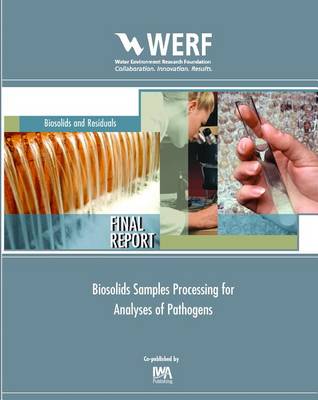WERF Research Report
1 total work
Biosolids Samples Processing for Analyses of Pathogens
by Morteza Abbaszadegan
Published 30 April 2008
This report will only be available as a Pay-Per-View item.
In this study, a two-step approach was used to develop new sample detection and processing methods that facilitate the application of molecular techniques to uses and disposal of biosolids. In the first phase, ten methods were compared for recovering pathogens in biosolids, and the three top performing methods were selected for optimization and expanded comparison for bacteria, viruses, and helminths. The selected methods were optimized for solid-to-eluent ratio, centrifugation rate, and centrifugation time. Beef-extract based methods resulted in average recoveries ranging from 42-92% and 37-85% for E. coli and Salmonella, respectively. The range of recoveries by the glycine based method were 53-61% and 64-92% for E. coli and Salmonella, respectively. Both of these methods proved superior than the EPA methods which resulted in 29-41% and 26-40% average recoveries for E. coli and Salmonella, respectively.
In the second phase, five commercially available kits were compared for removing PCR inhibitiors from sample concentrates. The Qiagen DNA purification kit was selected for integration into the new sample processing protocol which included a phenol-chloroform extraction step upstream of Qiagen cleaning. The lower limit of detection for DNA by the new method was established at between 10 and 100 nanograms in undiluted biosolid sample concentrates. The sample concentrates cleaned by our newly developed method were shown to be compatible with PCR, Real-time PCR, and a flow-through SPR biosensor technique. The new method was also successfully field tested for detecting human adenoviruses in land applied biosolids. This newly developed technique increases the applicability of PCR amplification for the detection of pathogens in biosolids. Utilization of our molecular method also offers a better classification tool for microbial pathogens (Class A and Class B) in biosolids.
In this study, a two-step approach was used to develop new sample detection and processing methods that facilitate the application of molecular techniques to uses and disposal of biosolids. In the first phase, ten methods were compared for recovering pathogens in biosolids, and the three top performing methods were selected for optimization and expanded comparison for bacteria, viruses, and helminths. The selected methods were optimized for solid-to-eluent ratio, centrifugation rate, and centrifugation time. Beef-extract based methods resulted in average recoveries ranging from 42-92% and 37-85% for E. coli and Salmonella, respectively. The range of recoveries by the glycine based method were 53-61% and 64-92% for E. coli and Salmonella, respectively. Both of these methods proved superior than the EPA methods which resulted in 29-41% and 26-40% average recoveries for E. coli and Salmonella, respectively.
In the second phase, five commercially available kits were compared for removing PCR inhibitiors from sample concentrates. The Qiagen DNA purification kit was selected for integration into the new sample processing protocol which included a phenol-chloroform extraction step upstream of Qiagen cleaning. The lower limit of detection for DNA by the new method was established at between 10 and 100 nanograms in undiluted biosolid sample concentrates. The sample concentrates cleaned by our newly developed method were shown to be compatible with PCR, Real-time PCR, and a flow-through SPR biosensor technique. The new method was also successfully field tested for detecting human adenoviruses in land applied biosolids. This newly developed technique increases the applicability of PCR amplification for the detection of pathogens in biosolids. Utilization of our molecular method also offers a better classification tool for microbial pathogens (Class A and Class B) in biosolids.
